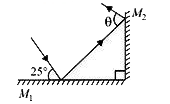How many times is a ray of light reflected by two plane mirrors placed parallel and facing each other?
To determine how many times a ray of light is reflected by two plane mirrors placed parallel and facing each other, we can follow these steps:
1. Understanding the Setup:
- We have two plane mirrors that are parallel to each other. This means they are positioned in such a way that they face each other directly.
2. Incident Ray:
- A ray of light is directed towards one of the mirrors. Let's say it strikes the first mirror (Mirror 1) at a certain angle.
3. First Reflection:
- When the ray hits Mirror 1, it reflects off at the same angle (according to the law of reflection, which states that the angle of incidence is equal to the angle of reflection).
4. Second Mirror Reflection:
- The reflected ray then travels towards the second mirror (Mirror 2). It strikes Mirror 2 and reflects off again, following the same law of reflection.
5. Continuous Reflections:
- The reflected ray from Mirror 2 will then travel back towards Mirror 1, where it will reflect again. This process continues indefinitely as long as the mirrors remain parallel and facing each other.
6. Conclusion:
- Since the ray of light continues to reflect back and forth between the two mirrors without any loss of energy (in an ideal scenario), the number of reflections that occur is infinite.
Final Answer:
- The ray of light is reflected an infinite number of times between the two parallel plane mirrors.
---
- We have two plane mirrors that are parallel to each other. This means they are positioned in such a way that they face each other directly.
- A ray of light is directed towards one of the mirrors. Let's say it strikes the first mirror (Mirror 1) at a certain angle.
- When the ray hits Mirror 1, it reflects off at the same angle (according to the law of reflection, which states that the angle of incidence is equal to the angle of reflection).
- The reflected ray then travels towards the second mirror (Mirror 2). It strikes Mirror 2 and reflects off again, following the same law of reflection.
- The reflected ray from Mirror 2 will then travel back towards Mirror 1, where it will reflect again. This process continues indefinitely as long as the mirrors remain parallel and facing each other.
- Since the ray of light continues to reflect back and forth between the two mirrors without any loss of energy (in an ideal scenario), the number of reflections that occur is infinite.
- The ray of light is reflected an infinite number of times between the two parallel plane mirrors.
Topper's Solved these Questions
- BOOK - NCERT EXEMPLARCHAPTER - LIGHTEXERCISE - SHORT ANSWER QUESTIONS6videos
LIGHT
- BOOK - NCERT EXEMPLARCHAPTER - LIGHTEXERCISE - LONG ANSWER QUESTIONS9videos
LIGHT
- BOOK - NCERT EXEMPLARCHAPTER - LIGHTEXERCISE - LONG ANSWER QUESTIONS9videos
LIGHT
- BOOK - NCERT EXEMPLARCHAPTER - FRICTIONEXERCISE - LONG ANSWER QUESTIONS3videos
FRICTION
- BOOK - NCERT EXEMPLARCHAPTER - SOME NATURAL PHENOMENAEXERCISE - LONG ANSWER QUESTIONS5videos
SOME NATURAL PHENOMENA
Similar Questions
Knowledge Check
- Question 1 - Select One
How many times is a ray of light reflected by two plane mirrors placed parallel and facing each other?
A2B4C8Dinfinite - Question 2 - Select One
How many images are formed when two plane mirrors are placed parallel to each other?
AOneBThreeCSevenDInfinite - Question 3 - Select One
The number of image of an object placed between two plane parallel mirrors is _____
AtwoBoneCinfiniteDCannot be determined
Two plane mirrors are inclined to each other at an angle θ. A ray of light is reflected at one
mirror and then at the other. Find the total deviation of the ray.View SolutionA ray of light is reflected by two perpendicular plane mirrors as shown. The angle θ is equal to:
 View Solution
View SolutionWhat should be the angle between two plane mirror's so that for all angles of incidence, the incident ray and the reflected ray from the two mirrors will be parallel to each other?
View SolutionWhat should be the angle between two plane mirror's so that for all angles of incidence, the incident ray and the reflected ray from the two mirros will be parallel to each other ?
View SolutionHow will you arrange the two plane mirros so that whatever may be the angle of incidence, the incident ray and the reflected ray from the two mirrors will be paralle to each other ?
View Solution

